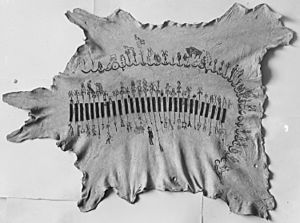Ankopaaingyadete facts for kids
Quick facts for kids
Anko
|
|
|---|---|
| Born |
Ankopaaingyadete (In The Middle Of Many Tracks)
|
| Died | early 1900s |
| Nationality | Kiowa |
| Known for | Winter count |

Ankopaaingyadete, often called Anko or In The Middle Of Many Tracks, was a talented Kiowa artist and historian. He lived in the late 1800s and early 1900s. Anko was famous for creating special calendars called pictographic winter counts. These calendars used pictures to record important events and tell the story of his people's history.
Contents
Anko: A Kiowa Artist and Historian
Anko was a member of the Kiowa tribe, a Native American group from the Great Plains. He was not just an artist; he was also a historian. He kept track of important events for his community. His unique way of recording history helps us understand the past of the Kiowa people.
What Are Winter Counts?
Winter counts are like visual diaries kept by some Native American tribes. They are often drawn on animal hides or paper. Each picture on a winter count represents a major event that happened during a year. Usually, the most important event of the winter was chosen to mark the entire year. This way, people could remember their history and tell stories about what happened.
Anko's Special Calendars
Anko created several different calendars. One of his first was a seasonal calendar. He drew it on brown wrapping paper. This calendar covered events from the winter of 1863 to the spring of 1885. It showed important moments over many years.
He also made a monthly record. This was drawn with a pencil in a ledger notebook. It showed 39 months from the late 1880s to the early 1890s. This calendar was very detailed, showing events month by month.
How Anko Recorded Time
On his calendars, Anko marked each month with a crescent moon symbol. He also added a small picture or symbol to represent the name of that moon. For example, October might be called "Geese-going Moon." Many of the events Anko recorded during this time were about his young wife's long illness.
Sharing His Work
Anko made several copies of his calendars. He drew them on buckskin, which is a type of soft leather. He even made a special copy with colored inks for ethnologist James Mooney. An ethnologist is someone who studies different cultures.
For Mooney, Anko combined his yearly and monthly calendars onto one piece of buckskin. The original monthly calendar was drawn in black ink in a continuous spiral shape. This made it easy to follow the timeline.
One of these buckskin calendars was once part of the Smithsonian Institution's collection, but it has since been lost. However, a copy of Anko's calendar, made in 1965 by another Kiowa artist named Charles Rowell, is kept at the Smithsonian National Museum of Natural History. This means Anko's important historical artwork can still be studied and appreciated today.

